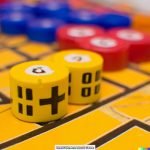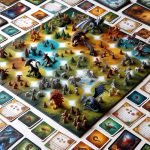Introduction
Making a Pokemon themed board game is a great way to have some fun with friends, family or rivals. Not only does a Pokemon themed board game provide an opportunity for players to challenge each other and come up with strategies around engaging the characters, the game is also a great way to learn about and discuss all the characters, powers and strategies that make Pokemon so exciting. The goal of such a board game could be something as simple as being the first player to reach a certain point in the game or as terrifyingly complicated as outguessing each character’s strengths and weak points in order to gain an edge over your opponent. There are numerous possibilities when it comes to setting up your own unique version of this classic card game. By making your own personalized edition of this beloved childhood game can make it feel more personal to you and ensure hours of intense competition among friends.
Gather Supplies
To make a Pokemon board game you will need to gather the following supplies: a board game template, dice (or card shuffling technique), clear cards, card backing paper stock, printable Pokemon characters and creatures, an image editing software program such as Adobe Photoshop or Microsoft Paint for printing out pictures if necessary, construction paper for making background cards and markers or paint to decorate them. For the board game template you can buy one from a store or online store. To obtain the clear cards, card stock and printouts of Pokemon characters and creatures you can shop around online for the best deals. Inkjet printers are ideal for providing high-resolution printing of all types of images. The construction papers come in packs found at craft stores like Michaels and Hobby Lobby and many office supply stores should also have paper packs available too. Lastly markers or paint can be used to design borders on each card, as well as decorations that fit with the aesthetic of your board game.
Design the Board
Designing the board for your Pokemon board game can be a lot of fun! To add interest and variety to the design, you can create points of interest on the map by adding features such as forests, ponds, mountains, rivers, roads, cities/villages etc. You could also add additional characteristics such as flourishing grasslands and mysterious caves. To make it look more interesting and visually appealing, consider adding interesting graphics or designs to the board ” think snow-capped mountains or a haunted forest. If you have access to 3D printed models of individual Pokemon characters, you could use those to populate the locations; if not then you can easily obtain Pokemon stickers which are widely available online and in stores. Additionally, you could also include challenge cards throughout the game which require players to draw cards in order to navigate through different areas that could contain various rewards or tasks that need completing or even gym battles. Have fun designing!
Create Pieces
Stickers are an excellent way to make pieces for your Pokemon board game. You can purchase sheets of Pokemon stickers, or create your own by cutting out pictures from trading cards or magazines. If you don’t want to use Pokémon images, you can also use other shapes and symbols, such as stars or hearts. If you own a printer and have access to cardstock paper, you can print out Pokémon images of traders and cut them into small pieces. Photographs can also be used if you would like a more personal touch”simply print out photos of family members or pets that represent different characters in the game. Pieces could also include 3-D objects such as coins, dice, buttons, rocks, Lego pieces, etc. Just make sure all the items are safe for everyone playing the game (babies and young children) before adding them to the set.
Develop Rules
Include a Go-to-catch mechanic – Create a custom die to add a mechanic that limits the number of Pokemon a player can catch. It should also track each player’s progress and determine when they win.
Set Up A Playing Field – Establish an arena for players to battle in with objects, hazards, and boundaries. Consider creating different terrains for players to navigate such as rocky ground, forests, or rivers.
Design Cards – Use software such as Photoshop or Illustrator to design characters and items cards with art reflective of the classic video games. Give each Pokemon a stats card related to their power level and utility in battle scenarios. Supplement the game with healing items, boosters, or other items a trainer would bring on their journey.
Create Custom Components – Develop miniatures with 3D printing technology based on characters in the game or build Lego structures depicting classic Pokemon locales like Gyms or Towns. You could even develop your own board tiles if you have enough 3D printer filament!
Introduce Scenarios – Include unique battles against Pokemon trainers in the form of challenges or tasks that need to completed before advancing through the game. This gives players an opportunity to earn points by defeating these opponents instead of only relying on point accumulation from traditional play methods such as catching more pokemon or collecting badges as proof of winning battles.
Share Your Creation
Sharing your finished Pokemon board game is an exciting part of the process! You can show it off to friends and family or even share it with the world by posting photos and videos online. Social media platforms such as Facebook, Instagram, and Twitter are all excellent places to share your work. There are also many communities dedicated to gaming fans where you can connect with other players who appreciate your craftmanship.
To facilitate online gameplay, consider using an app like Discord, which has built-in voice chat capabilities and allows users to join discussion servers to find opponents for their games. There are also apps specifically devoted to online board gaming such as Tabletop Simulator, which allows gamers from all around the world to play digital versions of their favorite board games with one another.
Conclusion
Readers can create a variety of different topics or types of board games. For example, they could create a fantasy-themed game that involves characters from popular fantasy franchises such as Harry Potter or Game of Thrones. They could also build a board game themed around classic video games like Super Mario Bros. or Sonic the Hedgehog. Alternatively, they could focus on creating a historical-themed game based on actual events or stories from the past. Finally, readers can create a board game centered on a certain topic of interest to them such as sports, science and technology, nature, current events, or anything else they have an in-depth knowledge of.

I love playing all kinds of games – from classics like Monopoly to modern favourites like Ticket to Ride.
I created this blog as a way to share my love of board games with others, and provide information on the latest releases and news in the industry.





